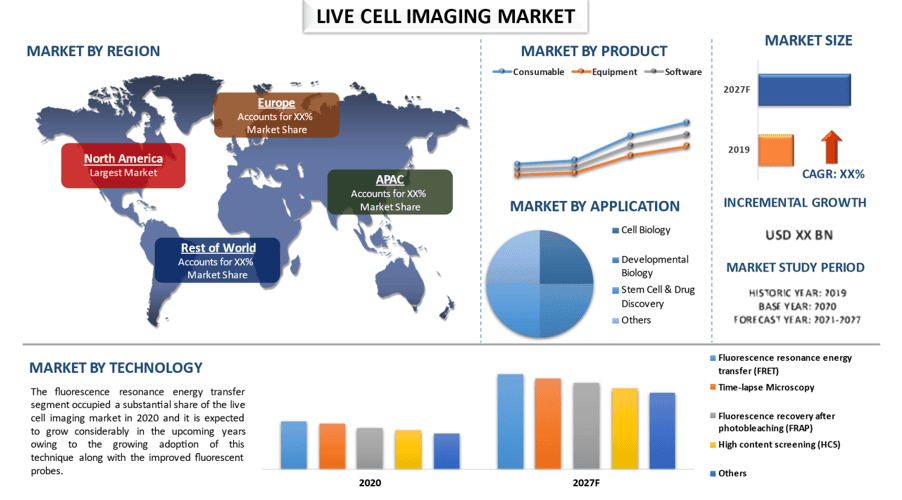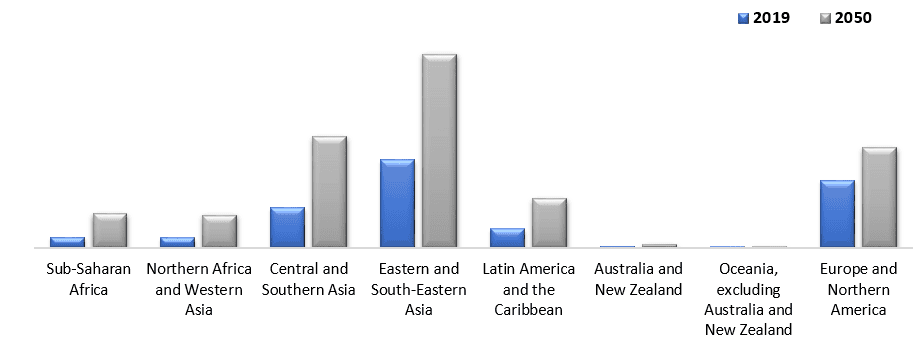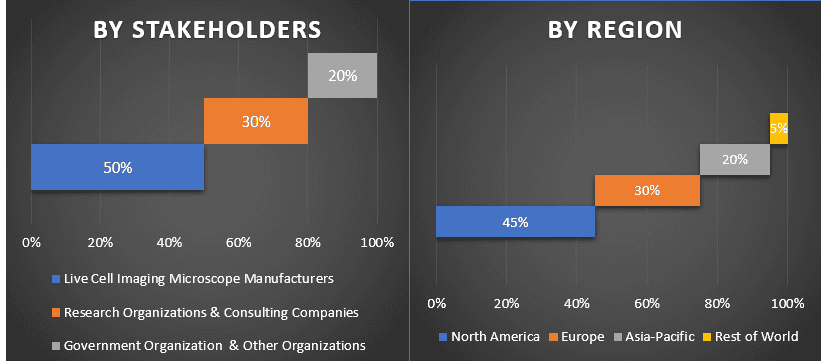- Home
- About Us
- Industry
- Services
- Reading
- Contact Us
Live Cell Imaging Market: Current Analysis and Forecast (2021-2027)
Emphasis on Product (Equipment, Consumables, Software); Technology (Time-Lapse Microscopy, Fluorescence Recovery After Photobleaching, Fluorescence Resonance Energy Transfer, High Content Screening, Others); Application (Cell Biology, Developmental Biology, Stem Cell & Drug Discovery, Others) End-Users (Pharmaceutical & Biotechnology Companies, Academic & Research Institutes, Contract Research Organizations(CROs)); Region and Country

Global Live Cell Imaging Market is anticipated to grow with an elevated CAGR of around 8% over the forecast period (2021-2027). The real-time study of cells using the images obtained from screening systems and microscopes is known as live-cell imaging. It plays a crucial role in understanding cell dynamics in various research fields including immunology, genetics, neurology, microbiology, etc. as it provides information with precision.
The live-cell imaging market is expected can be attributed to the rising prevalence of various chronic diseases coupled with a rapidly growing geriatric population. According to the United Nations, the 60+ aged population was 962 million in 2017 which is more than twice that it was in 1980 at 382 million. The number of elderly is expected to double again by 2050 and reach nearly 2.1 billion worldwide. Also, according to the Centers for Disease Control and Prevention, approximately 85% of older adults have at least one chronic health condition, and 60% have at least two chronic conditions. Owing to these facts, there is a growing demand for effective and quicker diagnostic facilities which can detect the disease at an early stage. Thereby, boosting the live cell imaging market.
Furthermore, with the growth in technological advancement and rising adoption of high content screening techniques, many industry players are focusing on launching new and advanced live cell imaging systems in the market globally. For example, in June 2021, CytoSMART Technologies launched two new fluorescence live-cell imaging systems, the Lux3 FL Duo Kit and the Multi Lux3 FL. The CytoSMART Lux3 FL Duo Kit is a compact and cost-effective imaging system consisting of two fluorescence microscopes and the CytoSMART Multi Lux3 FL fluorescence live-cell imaging system consists of four compact Lux3 FL devices, equipped with two fluorescent (green and red) and one brightfield channel.
Number of persons aged 65 years or over by geographic region, 2019 and 2050

PerkinElmer, Inc., Becton, Dickinson and Company, Carl Zeiss AG, Danaher Corporation, Olympus Corporation, Sartorius AG, Thermo Fisher Scientific, Nikon Corporation, Biotek Instruments, Inc., CytoSMART Technologies, are some of the prominent players operating in the live cell imaging market. Several M&As along with partnerships have been undertaken by these players to facilitate customers with live-cell imaging systems.
Insights Presented in the Report
“Amongst Product, consumables segment holds the major share”
Based on product, the live cell imaging market is segmented into equipment, consumables, and software. The consumables segment accounted for the largest market share in 2020 and it is estimated that it will exhibit a significant CAGR during the forecast period owing to the increasing use of live imaging systems across a wide range of applications for the diagnosis of disease and the need to purchase various consumables frequently.
“Amongst Technology, fluorescence resonance energy transfer segment holds the major share”
Based on the technology, the live cell imaging market is segmented into time-lapse microscopy, fluorescence recovery after photobleaching, fluorescence resonance energy transfer, high content screening, and others. The fluorescence resonance energy transfer segment occupied a substantial share of the live cell imaging market in 2020 and it is expected to grow considerably in the upcoming years owing to the growing adoption of this technique alongwith the improved fluorescent probes. Further, this technique enables researchers to study the energy transfer mechanism and the interaction of the proteins which in turn is also boosting the growth of this segment.
“Amongst Application, cell biology segment holds the major share”
Based on application, the market is fragmented into cell biology, developmental biology, stem cell & drug discovery, and others. In 2020, the cell biology application segment grabbed a considerable market share, and it is expected to grow at a significant CAGR during the forecast period mainly because of a substantial increase in the research and development studies performed on molecular interaction networks as live-cell imaging technology is used for understanding the elemental cellular structures as well as their interaction on the tissue level. Further, the growing adoption of this technology among cell biology researchers is also because it offers superior clarity of structural components and spatial heterogeneity.
“Amongst End-Users, pharmaceutical & biotechnology companies segment holds the major share”
Based on end-users, the market is fragmented into pharmaceutical & biotechnology companies, academic & research institutes, and contract research organizations(CROs). In 2020, the pharmaceutical & biotechnology companies segment grabbed a considerable market share, and it is expected to grow at a significant CAGR during the forecast period. The growth of this segment is attributed to the growing focus on cell-based research & development activities among these companies and an increasing number of patents on various drugs.
“North America represents one of the largest markets of live cell imaging market”
For a better understanding of the market dynamics of the live cell imaging market, a detailed analysis was conducted for different regions across the globe including North America (the U.S, Canada, and the Rest of North America), Europe (Germany, France, Spain, United Kingdom, Italy, and Rest of Europe), Asia-Pacific (China, India, Australia, Japan, and Rest of APAC), Rest of World has been conducted. North America constitutes a major market for the live cell imaging market industry and generated revenue of USD XX Million in 2020 owing to growing healthcare expenditure and an increase in the elderly population in the region.
Reasons to buy this report:
- The study includes market sizing and forecasting analysis validated by authenticated key industry experts
- The report presents a quick review of overall industry performance at one glance
- The report covers an in-depth analysis of prominent industry peers with a primary focus on key business financials, product portfolio, expansion strategies, and recent developments
- Detailed examination of drivers, restraints, key trends, and opportunities prevailing in the industry
- The study comprehensively covers the market across different segments
- Deep dive regional level analysis of the industry
Customization Options:
The global live cell imaging market can further be customized as per the requirement or any other market segment. Besides this, UMI understands that you may have your own business needs, hence feel free to connect with us to get a report that completely suits your requirements.
Table of Content
Analyzing the historical market, estimation of the current market, and forecasting the future market of the global live cell imaging market were the three major steps undertaken to create and analyze the adoption of live cell imaging in major regions globally. Exhaustive secondary research was conducted to collect the historical market numbers and estimate the current market size. Secondly, to validate these insights, numerous findings and assumptions were taken into consideration. Moreover, exhaustive primary interviews were also conducted, with industry experts across the value chain of the global live cell imaging market. Post assumption and validation of market numbers through primary interviews, we employed a top-down/bottom-up approach to forecasting the complete market size. Thereafter, market breakdown and data triangulation methods were adopted to estimate and analyze the market size of segments and sub-segments the industry pertains to. Detailed methodology is explained below:
Seek More Details About Research Methodology
Analysis of Historical Market Size
Step 1: In-Depth Study of Secondary Sources:
Detail secondary study was conducted to obtain the historical market size of the live cell imaging through company internal sources such as annual report & financial statements, performance presentations, press releases, etc., and external sources including journals, news & articles, government publications, competitor publications, sector reports, third-party database, and other credible publications.
Step 2: Market Segmentation:
After obtaining the historical market size of the live cell imaging market, we conducted a detailed secondary analysis to gather historical market insights and share for different segments & sub-segments for major regions. Major segments included in the report as product, technology, application, and end-users. Further country-level analyses were conducted to evaluate the overall adoption of live cell imaging across the globe.
Step 3: Factor Analysis:
After acquiring the historical market size of different segments and sub-segments, we conducted a detailed factor analysis to estimate the current market size of the live cell imaging. Further, we conducted factor analysis using dependent and independent variables such as the rising prevalence of various cancer and advancement in technology. A thorough analysis was conducted for demand and supply-side scenarios considering top partnerships, merger and acquisition, business expansion, and product launches in the live cell imaging sector across the globe.
Current Market Size Estimate & Forecast
Current Market Sizing: Based on actionable insights from the above 3 steps, we arrived at the current market size, key players in the live cell imaging market, and market shares of the segments. All the required percentage shares split, and market breakdowns were determined using the above-mentioned secondary approach and were verified through primary interviews.
Estimation & Forecasting: For market estimation and forecast, weights were assigned to different factors including drivers & trends, restraints, and opportunities available for the stakeholders. After analyzing these factors, relevant forecasting techniques i.e., top-down/bottom-up approach was applied to arrive at the market forecast about 2027 for different segments and subsegments across the major markets globally. The research methodology adopted to estimate the market size encompasses:
- The industry’s market size, in terms of value (US$) and the adoption rate of live cell imaging across the major markets domestically
- All percentage shares, splits, and breakdowns of market segments and sub-segments
- Key players in the live cell imaging market in terms of products offered. Also, the growth strategies adopted by these players to compete in the fast-growing market
Market Size and Share Validation
Primary Research: In-depth interviews were conducted with the Key Opinion Leaders (KOLs) including Top Level Executives (CXO/VPs, Sales Head, Marketing Head, Operational Head, and Regional Head, Country Head, etc.) across major regions. Primary research findings were then summarized, and statistical analysis was performed to prove the stated hypothesis. Inputs from primary research were consolidated with secondary findings, hence turning information into actionable insights.
Split of Primary Participants in Different Regions

Market Engineering
Data triangulation technique was employed to complete the overall market estimation and to arrive at precise statistical numbers of each segment and sub-segment of the live cell imaging market. Data was split into several segments & sub-segments post studying various parameters and trends in the areas of product, applications, technology and end-users of the live cell imaging market.
The main objective of the Live Cell Imaging Market Study
The current & future market trends of live cell imaging were pinpointed in the study. Investors can gain strategic insights to base their discretion for investments from the qualitative and quantitative analysis performed in the study. Current and future market trends were determined the overall attractiveness of the market at a regional level, providing a platform for the industrial participant to exploit the untapped market to benefit as a first-mover advantage. Other quantitative goals of the studies include:
- Analyze the current and forecast market size of live cell imaging in terms of value (US$). Also, analyze the current and forecast market size of different segments and sub-segments
- Segments in the study include areas of product, applications, technology and end-users
- Define and analysis of the regulatory framework for the live cell imaging industry
- Analyze the value chain involved with the presence of various intermediaries, along with analyzing customer and competitor behaviors of the industry
- Analyze the current and forecast market size of the live cell imaging market for the major region
- Major regions studied in the report include North America, Europe, Asia-Pacific, and Rest of the world
- Company profiles of the live cell imaging market and the growth strategies adopted by the market players to sustain in the fast-growing market
Deep dive regional level analysis of the industry
Related Reports
Customers who bought this item also bought










